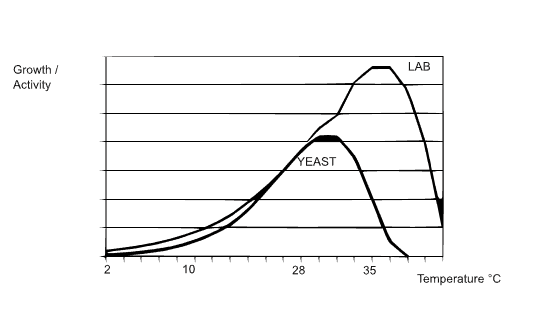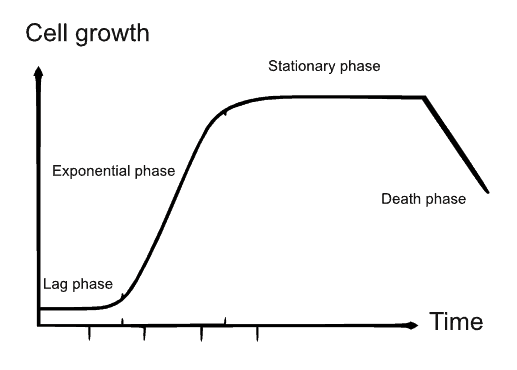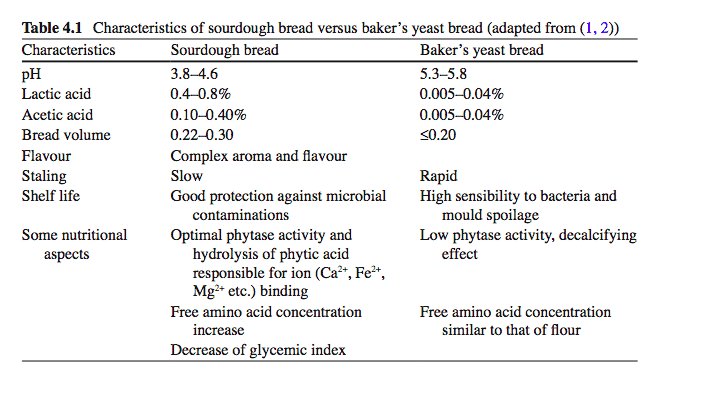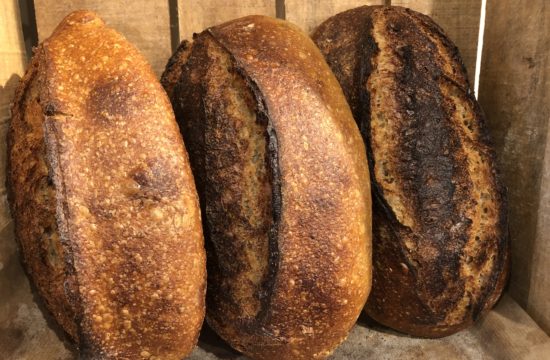Recipe rye sourdough batard
Subjects related to the sourdough workshop
- What is a sourdough culture?
- Is sourdough bread always sour?
- Important principles about baking with sourdough
- How much sourdough is needed to leaven the dough?
- How to make a starter
- Sourdough recipe
1 The starter, the dough and the culture?
The starter is normally a small amount of sourdough culture left in the fridge and used to build a larger amount of fresh and lively pre-ferment, which is used later on to flavour and leaven the bread. The sourdough culture contains microorganisms, i.e. natural yeasts and bacteria thriving in a starchy environment. This balanced culture has specific flavours and characteristics. The flavour depends mainly on it’s diet, i.e. what you feed it, how much and when you feed it, the temperature and hydration of the culture. As a rule of thumb, the yeasts in the sourdough culture are useful for the production of CO2 and leavening the bread, while the bacteria are good for producing organic acids, in particular lactic and acetic acid. Bacteria grow – much – faster than yeast and are relatively more common (1:100) in this culture, read more
Sourdough fermentations are characterized by a stable association of yeasts and lactobacilli. In sourdoughs with a tradition of continuous propagation, Lactobacillus sanfranciscensis (bacteria) , Candida miller (yeast) and Saccharomyces exiguus (yeast) are the predominant microorganisms.
Read more, Modeling of Growth of Lactobacillus sanfranciscensis and Candida milleri in Response to Process Parameters of Sourdough Fermentation (Michael G. Gänzle et al. 1998)
There is an analogy between a healthy sourdough culture, your gut and health. Watch the video lecture by Prof. Tim Spector about gut bacteria and health.
2 Is sourdough bread always sour?
Not necessarily. You can build up your sourdough pre-ferment in a way that the sourdough bread will have a mild pleasant taste. It’s mainly acetic acid that is experienced as acidic (pungent) and sometimes unpleasant. By developing your sourdough pre-ferment in a specific way you can adjust the acetic acidic levels of the final bread.
Is Zuurdesem (Dutch sourdough) a pleonasm?
On the origin of the word Desem
| Language | Word | Pronounce | Meaning | Wortel |
| Hebrew | ס ס ת | tasas ; | Ferment | t . s . s <*t . s |
| Old English | dæsma | Fermented dough | d . s m | |
| Old High German | deismo | d(ei)smo | Fermented dough | d . s m |
| Middle Dutch | deisom, desem ;tissen | d(ei)somdesem;tissen | Leave dough to ferment | d. s . m |
Tabel 1
Source: about the word desem (dutch sourdough)
Guidelines to make a starter
Method 1 to make a starter
| option 1 | option 2 | Days | starter | flour | water | temp °C | hours | total hours | location |
| T80 | whole wheat | day 1 +2 | 1 | 2 | 30 | 48 | 48 | warm | |
| T80 | whole wheat | day 3 | 1 | 1 | 1 | 30 | 24 | 72 | warm |
| T80 | white + fraction whole wheat | day 4 | 1 | 1 | 1 | 30 | 24 | 96 | warm |
| T80 | white + fraction whole wheat | day 5 | 1 | 1 | 1 | 35 | 24 | 120 | warm |
| T80 | white + fraction whole wheat | Dag 6 / part 1 | 1 | 1 | 1 | 35 | 14 | 134 | warm |
| T80 | white + fraction whole wheat | day 6 / part 2 | 0 | 0 | 0 | 10 | – | 144 | cool & mature |
Table 2
We use ratios in this table, when 1 is for example 100 grams of flour, than 2 means 200 grams of water. Since microbial growth can be exponential during favourable conditions one needs only very little starter culture for storage purposes in the fridge. What is T80 flour? Different flours have different effects on the buildup process of the sourdough pre-ferment. Read more about flours types
Second method to make a starter (more simpel)
Day 1 [start the process]
Half-and-half mixture of whole wheat flour and – medium – rye. Mix with same amount of water (35°C / 90° F). Keep at ambient temperature (30° C / 85° F) for around 24 hours [Temperature control: put the mix in a plastic bag and keep it close to you body for at least 24 hours, or take it to bed in a jar, what a joy]
Day 2 – 10 [stabilising the culture]
[Next 9 days: selection of micro organism, able to withstand acidy and low oxygen]Begin to feed the culture twice a day (morning and evening) with WHITE bread flour, hydration of 60% at approx. (21°C / 70° F)[The lower hydration promotes acidity and selects the microorganism (yeast and lactic acid bacteria) that can thrive in such acidic conditions]
Sensory cues
At the beginning of this stage the smell and flavor may not be good, since the culture is not stable. However, after 10 days, acidity, alcohol and fruitiness should be clearly detectable, the flavor should remind you of buttermilk or yogurt.
Promoting the yeast in starter culture
To further establish the wild yeast for proper leavening, feed the starter at least 3 times a day at about 25° to 26 °C, for 5 or 6 hours, at a hydration of 120 %. Feed again when you see considerable number of bubbles or /and when acidity (tanginess / acetic acid) is detected. Stop the consecutive feedings (reviving process) when many bubbles appear, but the acidity of the starter is mild. Use it for making a sourdough or refrigerate, for later use.
Storing the starter in the fridge and reviving it before use.
Keeping the starter below 10°C /50°F is said to be risky, as most yeasts used for bread making don’t thrive well at those temperatures. However, you can dry a healthy starter with extra flour (hydration 50 % – 60%) and slow it down before refrigerating it and keep it in the fridge for days or weeks. To revive it, simply feed it intensively for one or two days (warm 25°C to 26 °C, (77 – 79 °F) preferably at hydrations of +/-120 %). Once the sensory cues are good and after reestablishing the yeast you can use the starter to leaven your bread again. Note, you only need a little starter in the fridge, since you will be feeding it extensively in the building up or reviving process. In each feeding step you can increase the mass by doubling the previous mass or even increasing the previous mass 10 fold. In other words, throwing away lot’s of starter in the process doesn’t make sense.
More about making a starter
- Another method and tips about making a starter
- More information about sourdough in German
- Use T80 or whole-wheat flour (or rye), preferably bio, to make your own starter
- Whole-wheat flour has enough natural microbes to start the proces, while white flower is more suitable to tame the starter later on for storage purposes or when building the sourdough ferment in a controlled way prior to baking
- Rye flour has a more fermentable sugars (pentosans) that wheat flout, however not all microorganisms can thrive on such sugars.
- High temperatures (= 30 ° C promote enzymatic activity (sugar / protein fragments)
- Higher temperatures also promote the growth of lactic acid bacteria (Lactic Acid Bacteria = LAB) and formation of the more mild lactic acid
- After the first week (table above), the starter needs another 2 weeks to mature and ripen. However, you can already start using it to leaven your first sourdough breads
- A balanced sourdough culture “should” have a PH between 3.6 – 3.8 and have nice fruity smell or yogurt taste. Any idea which fruit has a comparable PH?
- Is temperature control difficult? Your own body is around 37 ° C, take your sourdough starter to bed for a few hours together, under the covers you probably have a nice temperature to further cultivate lactic acid bacteria and yeast. You can also use heating for a herbarium or terrarium to control the temperature.
Lactic Acid versus Acetic Acid ratio (80:20)
During fermentation organic acids are produced by the microbes. The most abundant are lactic acid and acetic acid. A ratio of 80% lactic acid (mild / yogurt taste) and 20% acetic acid (vinegar, corrosive and volatile) should be aimed for according to literature. Acetic acid prevents mold growth, but too much of it will be perceived as unpleasant and will reduce the quality of the bread. Long cold fermentation promotes formation of acetic acid.
How to influence the ratio between lactic acid and acetic acid?
- Hydration: higher hydration promotes lactic acid
- Temperature: higher temperature (30 – 35 ° C) promotes lactic acid
- Variation in temperature has more effect on acidification than differences in hydration
- Feeding the starter regularly promotes lactic acid formation
- Using white flour instead of whole-wheat flour promotes lactic acid. Whole wheat flour is more nutritious and promotes accelerated exponential growth which normally ends with more acetic acid.
Yeast versus bacteria
Which of the “two” microorganisms leavens the dough? The lactic acid bacteria produce mainly acids (flavour), while the wild yeasts produce CO2 and alcohol. During the build up of the sourdough ferment a balance between these two very different type of organisms is required.
Temperature ranges to work with
- <20 ° C promotion of acetic acid (LAB)
- 24 – 26 °C promotion CO2 (Yeast)
- 30-35 ° C promotion lactic acid (LAB)

Figure 1
Temperature dependance for the growth / activity of yeast and lactic acid bacteria. “Baker’s rule”; low temperatures during sourdough fermentations (20 to 27°C) are better for yeast growth than higher temperatures .

Figure 2
Sourdough is characterised by a culture of microorganisms. The figure displays it’s dynamics, i.e. lag, rise and fall.
More about sourdough dynamics
- Bacteria grow faster than yeast (20 – 30 min versus 90 -120 min)
- Bakers yeast and wild – sourdough – yeasts remain active longer under higher salt concentrations (up to 8%) , compared to lactic acid bacteria (4%)
- What spot should you aim for in the figure to promote a healthy and suitable baking culture [workshop] ?
- Why should you avoid dead cells in your starter [workshop]?
Myth, Air, Apples, Raisins and making a starter
You can find the most interesting and absurd stories on the internet about sourdough starters. Yes, yeast and bacteria are floating in the air, but you can start a culture without air. Most of the bacteria and yeast we need to develop a sourdough starter are where they should be, i.e. in your flour! Using fruits like apples and raisons to startup the process can speed up the development of the starter. Why, simply because fruits are sweet (readily available sugars) and because they provide a good Ph to start the fermentation with and therefore give a head start to the desired lactic acid bacteria, i.e. a low Ph or sour conditions. A starter doesn’t need oxygen. Fermentation is by definition a process that takes place in low concentration of or absence of oxygen. Claims about sourdough starters that have been a live for many generations in families reminds us probably that the story is often stronger than reality and in this case stronger than the starter itself, which probably died a few times while the story remained alive. Even if the starter survived for so many years, it’s composition is likely to have changed due to changes in climate conditions and feeding composition, see also reference above. A homemade sourdough culture is a dynamic adapting variety of microorganism.
Hooch, glutathione and proteases ?
A lively and fresh starter is important for your final sourdough bread for several reasons. Bear in mind that very high temperatures, too long fermentation times and too little fresh food (flour & water) will result in microbal death, releasing substances that may harm the taste and structure of the final bread. Dead microbes disintegrate and release glutathione, a molecule that strongly affects the gluten starch network, weakening the structure of the bread. Proteases are also released from dead cells. These are enzymes that cut proteins into smaller pieces causing additional gluten weakening.
Since alcohol is lighter than water, you can recognise a “bad” starter or builded pre-ferment as soon as a liquid layer of alcohol begins to appear on top of the starter. This layer may be a first indication that there many dead cells are present during buil up. This layer is also known as Hooch (USA), named after a “bad drink” made in the old days in America. More information about the origin of this “drink”.
- Hooch in called in German Fusel ; Ist das Anstellgut über Wochen nicht aufgefrischt worden, bildet sich auf der Oberfläche eine graue Wasser-Alkohol-Schicht („Fusel“).
- Any idea how to get rid of your Hooch?
Lets build a fresh sourdough ferment, prior to baking a loaf with it.
There are different ways to do this of course, or many roads that lead to a a good sourdough. Below is an example. Proportions are used, similar to the ones in table 2. The procedures allows you to make a sourdough bread that is not too sour. We build the natural pre-ferment in two steps. Note how we lean on the exponential phase (Figure 2) and that during final cooling , which takes time we allow the yeast to catch up! You can isolate the pre-ferment prior to putting it in the fridge to promote a more slowly cooling process and give the yeast enough time to catch up. To promote yeast growth a temperature of 27 °C is advised.
| phase | starter | flour | water | temp °C | time |
| 1 | 30 | 100 | 120 | 30 | 4 h / or many bubbless |
| 2 | 250 (from phase 1) | 1500 | 1800 | 30 | 3 h / or initial, few bubbles |
| 3 | Cool | x | x | 7 | +/- 12h or more |
| 4 | Mix, ferment and bake |
Table 3
Example of building a natural sourdough pre-ferment, Travelling through different temperature zones.
You should first mix the starter with warm water and mix it well, then add the flour and mix it into a homogeneous new builded pre-ferment.
This freshly build pre-ferment can be used in a ratio of about 35% to your total flour – weight. In other words, if you would have a recipe with a total of 100 gram flour, about 35 grams of the builded pre-ferment will be used in the final dough. Note that the flour and water used in this pre-ferment should also be included in the total formula. Note also that natural sourdough breads require usually 2 to 3 times more time than conventional commercial yeast recipes to leaven the bread.
You should practice how to evaluate the dough and decide when it’s proofed enough (poking test) and ready to bake.
You can build your final sourdough pre-ferment in different ways, learn more about building professional sourdough using the detmolder method (German).
You can learn much about sourdough by studying the Detmolder below (3 phase method).
what can you learn for example?
- order of building the culture, e.g. first establishing a good yeast culture ( promote co2 production later on in the proces)
- the production of two type of acids ( acetic acid & lactic acid) is promoted in different conditions (hydration levels, reaction speed) and temperatures (reaction speed) and time.
Feeding ratio => soured flour: new flour, meaning 1:10, mix 1 gram of soured flour with 10 grams of new or fresh flour.
Phase 1 (yeast promotion, feeding ratio 1:5 )
- 150 % hydration
- 5 – 6 hours
- 26 °C
Phase 2 ( acetic acid promotion, feeding ratio 1:10)
- 65 % hydration
- 22 °C – 24 hours
- 27 °C – 15 hours
Phase 3 (lactic acid promotion, feeding ratio 1:2)
- 100 % hydration
- 3 a 4 hours
- 30 °C
- This fully developed, i.e. prefermented sourdough, is then mixed with the rest of the flour to make the final bread dough. Approximately 30 – 45% of the total dough is prefermented this way (flour ratio). Perhaps more important than these numbers is get to know your sourdough. Smell and taste it. A well developed sourdough should smell and taste pleasant, like yogurt or buttermilk.
How much sourdough pre-ferment % ?
Many sourdough recipes call for pre-ferments that vary between 10% to 50% related to the final dough weight (30-45% detmolder method). The lower percentage is advocated for longer fermentation times and final – overnight – proofing in the fridge, while the higher percentages are more suitable for a warm and rapid final fermentation, proofing and baking, also depending on whether commercial yeast is used in the recipe, which is normally the case for professional bakeries. The longer and warmer the final proof, the more sour the bread.
Climate, process and words?
Perhaps a bit far fetched, but could it be that climate has played a role in the words chosen for the natural fermentation process? See the proportion of lactic acid (mild) versus acidic acid (pungent) in relation to temperature and the climate regions below:
Sauerteig (German, sour….)
Sourdough (English, sour…)
Levain (French, rise, i.e. no reference to the word sour….)
Lievitare (Italian, rise, no reference to the word sour……)
Masa madre (Spanish, given from mother to daughter)
Levain: Latin levamen “alleviation, mitigation,” but used in Vulgar Latin in its literal sense of “a means of lifting, something that raises,” from levare “to raise” (see lever).
Sourdough bread characteristics, health and flavour

Table 4
Reference: Handbook Sourdough 2013 , Marco Gobbetti • Michael Gänzle
More info on Sourdough and celiac disease (gluten-sensitive enteropathy), sometimes called sprue or coeliac
Sourdough recipe
Use our basic bread recipe remains your guide/ Replace the pinch of yeast by 10 % of lively sourdough culture. To promote good results make sure the sourdough starter you use is lively and fresh. Feed your cold and sleepy sourdough starter (lag phase!) at least once every 12 hours (room temp) for one or 2 days before you start using it to leaven the dough. This is an important step to ensure you are using a fresh and lively culture that should promote better leavening results with more balanced acid formation. When your starter smells and tastes good (yogurt / fruity) and is very bubbly put it in the fridge to use the next day or when its warm and still good, use directly. Remember, every culture might behave differently and you will have to experiment to find which procedures (e.g. how long is your ideal warm dough fermentation) work best for your culture, flour, hydration etc. Incorporating some extra bakers yeast in the proces can help you get a better rise. Another tip. When preparing a new dough, first mix the water with the starter so that you ensure a nice mix of your culture before adding the flour and making a final dough.
Another – detailed – sourdough recipe
STRATEGY & MICROBAL OUTCOMPETE “GAMES”
Ethanol (alcohol)
- Certain strains of heterofermentative lactobacilli are known
to grow at ethanol concentrations as high as 18%. - the ethanol concentration in doughs does not exceed 1%, it is unlikely to exert an inhibitory effect on lactobacilli but may contribute to the inhibition of yeast growth and contributes to stronger dough.
- The growth of the wild Saccharomyces cerevisiae is inhibited when the medium contains 6 % or more ethanol.
Acids
- Many yeast including wild Saccharomyces cerevisiae (bakers yeast) are sensitive to acetic acid, reducing their activity.
- At low Ph (below 4), the acids start to prevent growth & activity, reducing the Co2 production. So you want to prevent over acidification of your dough (Balance!) , and especially minimise the promotion of acetic acid.
- Too much acids and to little Co2 in your dough will result in baking “plastic” in the oven instead of making bread.
Salt
- Yeast (Candida milleri) tolerates up to 8% NaCl (salt)
- Lactobacillus sanfranciscensis (common in sourdough cultures), inhibited by 4% NaCl (salt)
Symbiotic relationships
Microbiology and Technology of Fermented Foods By Robert W. Hutkis
Several physiological and biochemical properties are now known to be responsible for the stable symbiotic relationship between Lactobacillus Sanfranciscensis and C. Milleri and their ability to grow together in bread dough. First Lactobacillus Sanfranciscensis is heterofermentative, producing acetic and lactic acid, ethanol and CO2. The PH of the dough can drop as low as 3.5 , a PH that is inhibitory to competing organisms, including bakers yeast strains of Saccharomyces Cerevisiae . In contrast, C. Milleri (and related species) is acid-tolerant and benefits by the lack of competition from other acid sensitive yeast. The yeast (C. Milleri) in turn, releases free amino acids and other nutrients need by the Lactobacillus Sanfranciscensis. There is also a fascinating metabolic component to the Lactobacillus Sanfranciscensis C. Milleri symbiotic partnership. Most of the fermentable carbohydrates found in the sourdough is in the form of maltose. Whereas S. cerevisiae, the ordinary bakers yeast, readily ferments maltose, C. Milleri is unable to ferment this sugar leaving this organism without an obvious substrate for growth. In contrast, Lactobacillus Sanfranciscensis not only prefers maltose as a carbohydrate source, but ferments this sugar in a particular relevant manner.
Ordinarily , one might expect that the metabolism of disaccharide maltose would result in both glucose moieties being fermented. However when Lactobacillus Sanfranciscensis grows on maltose it uses the cytoplasmic enzyme maltose phosphorylase to hydrolyze the accumulated maltose, yielding free glucose and glucose-1popphospahet. The later is isomerized to glucose-6-phospahte, which then feeds directly into the heterofermentative phosophoketolase pathway. The glucose generated by the reaction is not further metabolized, but rather is released into the extracellular medium, or in this case the dough (available for C. Milleri, which can’t ferment maltose, and depends on glucose). Glucose excretion occurs in part because maltose is transported and hydrolyzed so rapidly that more glucose is formed than the cell can handle.
References
- Engineering Saccharomyces cerevisiae for improvement in ethanol tolerance by accumulation of trehalose Nileema R. Divate, Gen-Hung Chen, Pei-Ming Wang, Bor-Rung Ou & Yun-Chin Chung
- Handbook Sourdough 2013 , Marco Gobbetti • Michael Gänzle
- Modeling of Growth of Lactobacillus sanfranciscensis and Candida milleriin Response to Process Parameters of Sourdough Fermentation
- Dynamics of Microbiota in Three Backslopped Liquid Sourdoughs That Were Triggered with the Same Starter Strains

